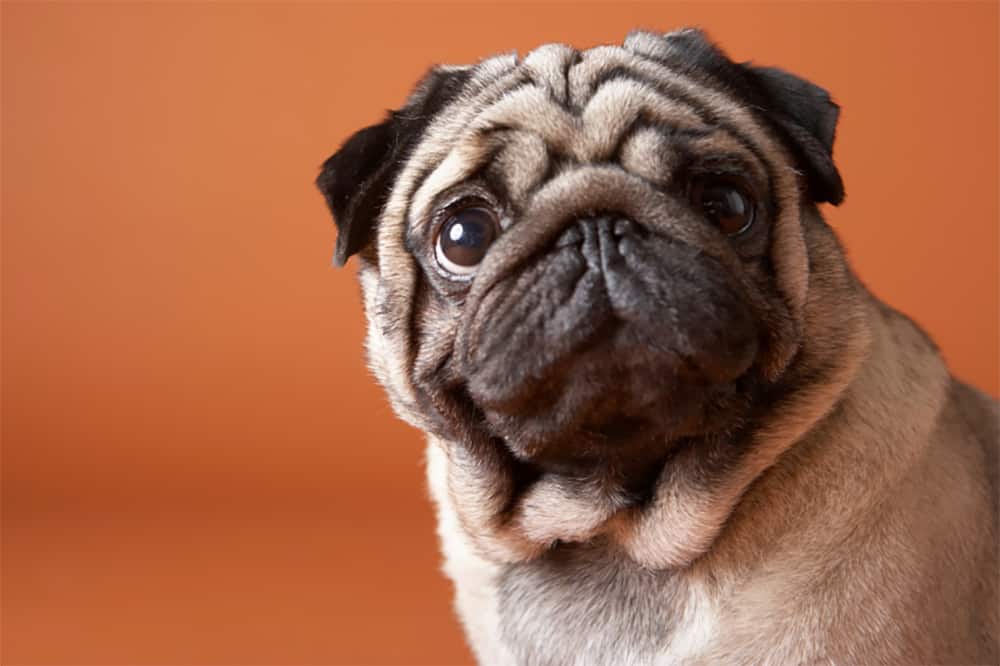Whether you’ve recently become the owner of an adorable little pug or you’re currently considering adding one to your life, it’s important to make sure that you’re well aware of the potential health issues and care responsibilities that you will have to uphold as an owner throughout your pug’s life.
Even though all kinds of breeds of dogs require plenty of love, affection, and care throughout their lives, pug’s are an especially unique breed of dog, which means that they can be prone to developing a variety of diseases that aren’t typically seen in other dogs, and this mainly comes down to their special appearance.

To help you gain a greater understanding of this loveable breed of dog, in this article we’re going to be talking you through the general lifespan of the pug, what some of the main health issues that they are prone to are, as well as some tips and advice on how to help prolong your pug’s life.
So, whenever you’re ready, just read on.
The Average Lifespan Of The Pug
To kick this guide off, first things first we’re going to be taking a deep dive look into the average lifespan of the pug, so that you can gain a greater understanding of whether or not introducing one into your life is the best option for you, your family and your personal circumstances.
Generally speaking, pugs live for an average lifespan of around 12 to 15 years, although do keep in mind that this figure can vary from dog to dog.
However, even though pugs do have the ability to be able to live up to 15 years of age, it is important to keep in mind that pugs typically tend to live for a period of time far shorter than this, and the main reason for this comes down to the fact that pugs are generally prone to developing a variety of different diseases all throughout their lives, while other breeds of dog tend to be prone to developing diseases during old age.
It’s also important to note that one of the main reasons for this typically comes down to the fact that pugs have unique, wrinkled faces that are not seen in other types of dogs.
In addition to the unique, potential complications that can be caused by the unique structure of the pug’s face, it is also important to keep in mind that the pug also typically tends to suffer from a variety of other illnesses that can strike at any point during the pug’s average life.
Nevertheless, while this might be the case, there are a variety of steps that can be taken to help prevent and prolong the lifespan of a pug, and we’ll be talking you through everything that you need to know about in the next few sections.
Common Health Problems Typically Seen In Pugs
So, now that you have a greater understanding of the average lifespan of a pug, we’re now going to be taking a moment to talk you through some of the most common health problems that are typically experienced by the pug breed.
As we have already mentioned briefly above, due to the way that pugs were originally bred to have a unique appearance, it means that they are at a higher risk of developing a variety of rare illnesses and diseases that are not typically associated with any other type of breed of dog.
To make sure that you are well aware of the responsibilities that can come along with owning a pug, as well as to make sure that you can be the best dog owner you can be, we’re going to be breaking down these health problems below, so that you can gain a better understanding of what to expect if you do decide to become the owner of a pug:

Brachycephalic-Related Issues
First things first, even though pugs are very clever and affectionate little dogs, they are officially classified as being a brachycephalic breed, which is otherwise referred to as a flat-faced breed.
While we have already briefly mentioned above that the unique appearance of a pug’s face can cause them to develop a variety of health issues that are not seen in dog’s that are not classified as being a brachycephalic breed, it is important to make sure that you’re well aware of this before you decide to go ahead and buy yourself a pug.
This condition of their face can mean that they are at risk of breathing problems all throughout their life, as well as additional issues including skin infections and eyelid problems.
Kneecap Problems
Due to their smaller, “stout” sizes, it means that pugs can sometimes be at risk of developing issues with their kneecaps. Most commonly, pugs are at a high risk of developing something known as Luxating Patellas, which is a condition that consists of the kneecaps slipping out of place.
This can be very painful for pugs as it means that the kneecaps need to be popped back into their proper position, and once developed, this condition is typically reoccurring and can strike at random times.
Elbow/Hip Dysplasia
Pugs are also at a high risk of developing either (or both) elbow dysplasia and hip dysplasia.
Dysplasia is essentially a term that is used to describe the presence of abnormal cells that have accumulated within either a tissue or organ or more specifically either the elbow areas or hip areas.
While it’s important to note that dysplasia is not cancer, it does have the possibility of developing into cancer later down the road, which is why it’s important to make sure that you are taking your pug for regular check-ups at the vet so that the abnormal cells in the area affected can be kept a close eye on.
Additionally, it’s also important to note that dysplasia can range in severity from mild to severe, and is ultimately dependent on how many abnormal cells are present within either the elbows or the hips, as well as how much of the area is affected by the presence of these abnormal cells, too.
Skin Infections
As we have already touched upon above, another common issue that pugs tend to experience due to their unique facial appearance is skin infections.
While skin infections are not overly common in healthy, well-cared-for pugs that are being regularly cleaned by their owners, pugs are still at a high risk of developing skin issues due to the air-tight folds that are across the entirety of their faces.
Eye Problems
Due to the way that pugs have been bred, it means that they typically tend to have shallow eye sockets, and these shallow eye sockets can occasionally lead to a variety of different eye issues throughout their lives.
While the severity and likelihood of eye problems can vary from pug to pug, for the most part, most pugs are at a higher risk of developing persistent eye infections, ulcers located in the corneal, as well as eye trauma and dry eye.
How To Prolong A Pug’s Life
Now that you’ve gained a greater understanding of the average lifespan of a pug, as well as some of the most common health issues that pugs are at a higher risk of developing throughout their lives, we’re now going to be talking you through some of the best ways that you can help to prolong your dog’s lifespan.
Let’s take a look at them below:
Diet
One of the biggest factors that can help to increase your adorable pug’s life is to make sure that you are providing them the best diet possible.
As we’re sure you might already know if you are familiar with pugs, they do tend to be a breed of dog that is more likely to gain weight as opposed to other dogs, so it’s important to try and make sure that you are giving your pug healthy foods and keeping treats to a minimum.
Even though every pug’s diet will be different, for the most part, all pug’s should be eating a diet that isn’t full of too much fat, additives, or nasty preservatives. Instead, you should make sure that you are giving your dog plenty of organic, natural foods that contain a variety of nutrients to make sure that your pug is healthy.
Exercise
Alongside making sure that your pug is enjoying a well-balanced diet, you should also make sure that your pug is getting the recommended amount of daily exercise per day, as well as making sure that your pug has plenty of fun toys to play with and stay active with.
Not only will you make sure that your pug gets a daily walk helps to ensure that your dog is happy and healthy, but it will also work to prevent different health issues from forming that can be influenced by a more sedentary lifestyle.

However, as a side note, due to the fact that pugs are classified as being a flat-faced breed of dog, it’s important that you make sure you aren’t overdoing your pug’s exercise and daily playtime sessions, as working too hard could potentially cause your pug to struggle to catch its breath.
Check-Ups At The Vet
Even though we’re sure you’re already well aware of this point, it’s still important to highlight!
One of the best ways that you will be able to help prolong your dog’s lifespan is to simply make sure that you are taking your pug in for regular check-ups at the vet’s office.
Even though many dog owners take their dog to the vet in the instance of an emergency or if they feel as though something is seriously wrong with their dog, it’s very important to make sure that you are actually scheduling around 1-2 check-up appointments each year, as this will allow your pug to be checked over just in case there is anything wrong.
In addition to this, we also strongly recommend that you make sure to take your pug in for annual checkups due to the fact that pugs are more prone to developing certain diseases and illnesses that have a higher survival rate (as well as an increased quality of life) if caught early.
Hygiene
Some other ways that you can work to prolong your dog’s lifespan is by making sure that you are staying on top of your dog’s grooming routine and hygiene care.
For starters, you should ensure that you are staying on top of your pug’s oral hygiene, as this will help to make sure that your dog’s teeth are healthy and in good condition.
If your pug struggles with dog toothbrushes, then you could alternatively opt to include tooth cleaning treats, such as these.
In addition to oral hygiene, it is also very important that you are cleaning your pug’s face and body each week, making sure that you are carefully and thoroughly cleaning all the fold’s in your pug’s face, as this will help to prevent skin infections from occurring, while also ensuring that your dog is as comfortable and content as can be.
Bonding Time
Another hugely important factor to helping to prolong your pug’s life is making sure that you are scheduling plenty of bonding time with your pug! As we’re sure you’re already well aware, pugs are an extremely affectionate and sociable breed of dog that requires plenty of social interaction in order to remain happy.
As the owner of your very own pug, it’s extremely important that you are making sure you are spending plenty of quality time with your pug throughout the day, otherwise, your pug might begin to experience feelings of sadness, anxiety, and potentially even depression.
Even if you lead a very busy lifestyle, you should be sure that you are taking your pug on regular walks, while also spending plenty of time keeping your pug company and engaging in plenty of fun activities that will help to strengthen your bond.
While bonding time might not necessarily be able to outright prevent certain illnesses from occurring in your pug, it will be able to significantly increase the quality of your pug’s life and overall happiness levels which we think is extremely important.
Grooming
Besides making sure to enjoy plenty of bonding activities with your pug, another way that you can help to prolong your pug’s life is by making sure to create a regular grooming routine.
While it might not seem like a regular, consistent grooming routine will be able to help increase your dog’s lifespan, due to the fact that pugs tend to have lots of folds and wrinkles across their skin, it means that grooming will be able to help keep your pug’s skin and coat healthy.
Frequently Asked Questions
What Age Do Pugs Start Having Health Problems?
If you’re currently planning on introducing an adorable little pug into your family, it’s important to make sure that you’re well aware of the potential health issues that many pugs are at risk of developing due to their unique appearance.
Even though most pugs won’t begin to display signs of health problems until mid to later life, it is important to keep in mind that some pugs can begin to display health problems during the puppy stage, and it usually starts off with a limp.
If you suspect that your pug is beginning to display signs of having a health problem, you should be sure to take them to your vet, who will be able to advise on the necessary steps to help overcome the health problem.
What Is The Life Expectancy Of A Pug?
The average lifespan of a pug is about the same as other types of dog, which works out to around 12-15 years.
However, while this might be the case for some pugs, it is important to keep in mind that due to the fact that pugs are at a higher risk of developing certain types of health problems almost exclusive to their breed, it means that this lifespan frame can sometimes be unfortunately shorter than the average lifespan figure.
What Are Common Health Problems For Pugs?
Some of the most common health problems that pugs can experience are hip and elbow dysplasia, obesity, arthritis, kneecap issues, eye problems, breathing problems, and much more due to the pug’s unique appearance.




